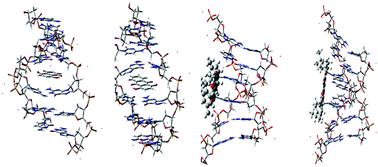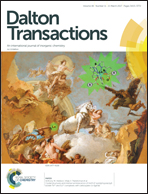Interstrand DNA covalent binding of two dinuclear Ru(ii) complexes. Influence of the extra ring of the bridging ligand on the DNA interaction and cytotoxic activity†
Abstract
In this work, we report experimental and computational evidence for the intercalation into the DNA base-pairs of the free quinones quinizarin (Q) and naphthazarin (N) and the interstrand covalent binding of their p-cymene di-ruthenium(II) complexes (Cl2Ru2X, with X = N, Q bridging ligands). The intercalation extent for the N complex was larger than that for Q, which is in good agreement with the higher relative contour length and melting temperature for the same CX/CDNA ratio and with the computational mean stacking distances between the ligand and the nearest base-pair (3.34 Å and 3.19 Å) for N and Q, respectively. However, the apparent binding constant of Q/DNA, two orders higher than that of N/DNA, indicates that the thermal stability of the X/DNA complex is more related to the degree of intercalation than to the magnitude of the binding constant. Cl2Ru2X complexes undergo aquation, forming the aqua-derivatives [(H2O)2Ru2X]2+. These can further bind covalently to DNA via interstrand crosslinking, through both Ru centres and two N7 sites of consecutive guanines, to give (DNA1,2)Ru2X complexes, by a mechanism similar to that of cisplatin. To the best of our knowledge, this type of interaction with dinuclear Ru(II) complexes has not been reported hitherto. The experimental and computational results reveal that the number of rings of the aromatic moiety and the covalent binding to DNA play a key role in the behaviour of the quinones and their Ru(II) derivatives. The cytotoxicity of the ligands and the corresponding Ru(II) complexes was evaluated in MCF-7, A2780, A2780cis tumour cells and in the healthy cell line MRC-5. The cytotoxic activity was notable for N and negligible for Q. The IC50 values and the resistance (RF) and selectivity (SF) factors show that the Cl2Ru2N complex is the most promising among the four studied anticancer drugs.



 Please wait while we load your content...
Please wait while we load your content...